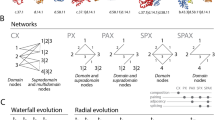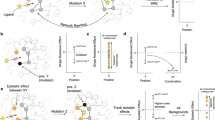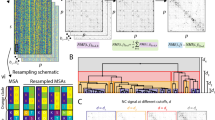Abstract
Modularity, which has been found in the functional and physical protein interaction networks of many organisms, has been postulated to affect both the mode and tempo of evolution. Here I show that in the yeast Saccharomyces cerevisiae, protein interaction hubs situated in single modules are highly constrained, whereas those connecting different modules are more plastic. This pattern of change could reflect a tendency for evolutionary innovations to occur by altering the proteins and interactions between rather than within modules, in a manner somewhat similar to the evolution of new proteins through the shuffling of conserved protein domains.
This is a preview of subscription content, access via your institution
Access options
Subscribe to this journal
Receive 12 print issues and online access
$209.00 per year
only $17.42 per issue
Buy this article
- Purchase on Springer Link
- Instant access to full article PDF
Prices may be subject to local taxes which are calculated during checkout

Similar content being viewed by others
References
Needham, J. Biol. Rev. 8, 180–233 (1933).
Gerhart, J. & Kirschner, M. Cells, Embryos, and Evolution (Blackwell Science, Malden, Massachusetts, 1997).
Hartwell, L.H., Hopfield, J.J., Leibler, S. & Murray, A.W. Nature 402, C47–C52 (1999).
Schlosser, G. Theory Biosci. 121, 1–80 (2002).
Schlosser, G. & Wagner, G.P. (eds.) Modularity in Development and Evolution (University of Chicago Press, Chicago, Illinois, 2004).
Fisher, R.A. The Genetical Theory of Natural Selection (Dover, New York, New York, 1930).
Waxman, D. & Peck, J.R. Science 279, 1210–1213 (1998).
von Mering, C. et al. Nature 417, 399–403 (2002).
Han, J.D. et al. Nature 430, 88–93 (2004).
Hirsh, A.E., Fraser, H.B. & Wall, D.P. Mol. Biol. Evol. 22, 174–177 (2005).
Fraser, H.B., Hirsh, A.E., Steinmetz, L.M., Scharfe, C. & Feldman, M.W. Science 296, 750–752 (2002).
Jordan, I.K., Marino-Ramirez, L., Wolf, Y.I. & Koonin, E.V. Mol. Biol. Evol. 21, 2058–2070 (2004).
Krylov, D.M., Wolf, Y.I., Rogozin, I.B. & Koonin, E.V. Genome Res. 13, 2229–2235 (2003).
Doolittle, R.F. Annu. Rev. Biochem. 64, 287–314 (1995).
Fraser, H.B., Hirsh, A.E., Wall, D.P. & Eisen, M.B. Proc. Natl. Acad. Sci. USA 101, 9033–9038 (2004).
Acknowledgements
I thank J. Plotkin and A. Hirsh for suggestions. This work was supported by a National Science Foundation predoctoral fellowship.
Author information
Authors and Affiliations
Corresponding author
Ethics declarations
Competing interests
The author declares no competing financial interests.
Supplementary information
Rights and permissions
About this article
Cite this article
Fraser, H. Modularity and evolutionary constraint on proteins. Nat Genet 37, 351–352 (2005). https://doi.org/10.1038/ng1530
Received:
Accepted:
Published:
Issue Date:
DOI: https://doi.org/10.1038/ng1530
This article is cited by
-
Aligning functional network constraint to evolutionary outcomes
BMC Evolutionary Biology (2020)
-
MTGO: PPI Network Analysis Via Topological and Functional Module Identification
Scientific Reports (2018)
-
Beyond Royalactin and a master inducer explanation of phenotypic plasticity in honey bees
Communications Biology (2018)
-
Rewiring of the inferred protein interactome during blood development studied with the tool PPICompare
BMC Systems Biology (2017)
-
Structuring evolution: biochemical networks and metabolic diversification in birds
BMC Evolutionary Biology (2016)



